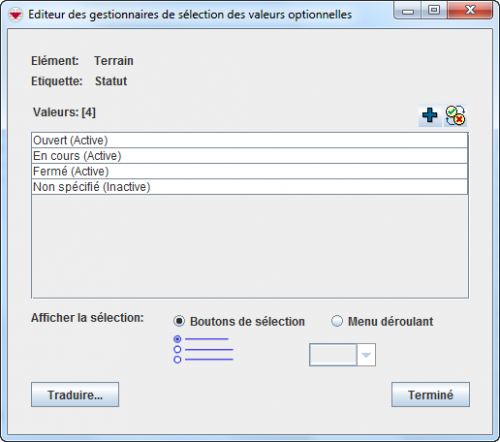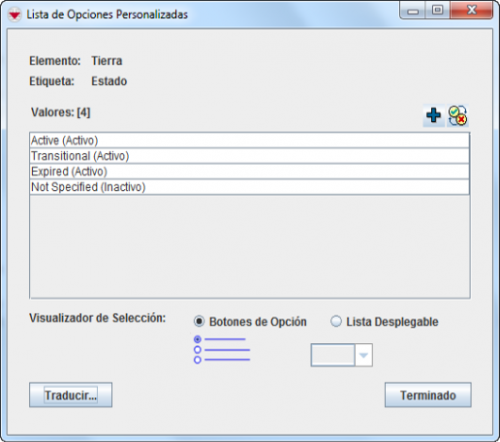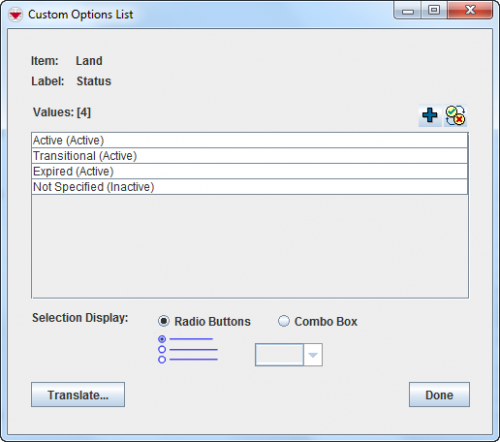Difference between revisions of "Language Issues"
| Line 1: | Line 1: | ||
As described in [[Change the Language | How does IMSMA know which language to use?]] it is the Regional settings on your computer in combination with the language files in the C:\IMSMAng\client\resources\com\fgm\imsma\lexicon folder which determine which language {{IMSMANG}} will use. | As described in [[Change the Language | How does IMSMA know which language to use?]] it is the Regional settings on your computer in combination with the language files in the C:\IMSMAng\client\resources\com\fgm\imsma\lexicon folder which determine which language {{IMSMANG}} will use. | ||
| + | |||
| + | The best database field to use for checking if the translations are complete for a language is ''Status'' in Land in the Data Inventory Manager category ''Uncatgorised''. | ||
==Case {{IMSMANG}} has all files for the language==__NOEDITSECTION__ | ==Case {{IMSMANG}} has all files for the language==__NOEDITSECTION__ | ||
| − | + | In this case the regional settings is set to French (France) and the menus etc. are in French and the enumeration values are '''with''' translations. | |
| + | [[Image:French w trans.png|500px|center]] | ||
| + | <div align="center"> | ||
| + | '' The French translation of enumeration values have been imported into the database '' | ||
| + | </div> | ||
==Case {{IMSMANG}} does not have all files for the language OR the translations have not been imported to the database==__NOEDITSECTION__ | ==Case {{IMSMANG}} does not have all files for the language OR the translations have not been imported to the database==__NOEDITSECTION__ | ||
| − | In this case the regional settings is set to Spanish (Colombia) and the | + | In this case the regional settings is set to Spanish (Colombia) and the menus etc. are in Spanish but the enumeration values are '''without''' translations. |
[[Image:Spanish wo trans.png|500px|center]] | [[Image:Spanish wo trans.png|500px|center]] | ||
| Line 28: | Line 34: | ||
# [[Import the Translated Terms|import]] the file as the local language/variation. | # [[Import the Translated Terms|import]] the file as the local language/variation. | ||
| + | ==Case {{IMSMANG}} have files for the language but you do not want to use them==__NOEDITSECTION__ | ||
{{NavBox Technical Notes}} | {{NavBox Technical Notes}} | ||
[[Category:NAA]] | [[Category:NAA]] | ||
Revision as of 09:29, 1 August 2016
As described in How does IMSMA know which language to use? it is the Regional settings on your computer in combination with the language files in the C:\IMSMAng\client\resources\com\fgm\imsma\lexicon folder which determine which language IMSMANG will use.
The best database field to use for checking if the translations are complete for a language is Status in Land in the Data Inventory Manager category Uncatgorised.
Contents
Case IMSMANG has all files for the language
In this case the regional settings is set to French (France) and the menus etc. are in French and the enumeration values are with translations.
The French translation of enumeration values have been imported into the database
Case IMSMANG does not have all files for the language OR the translations have not been imported to the database
In this case the regional settings is set to Spanish (Colombia) and the menus etc. are in Spanish but the enumeration values are without translations.
The Spanish translation of enumeration values have not been imported into the database
See this page how to create Spanish translation for enumeration values.
Case IMSMANG does not have files for the language
If the regional settings is set to e.g. Swedish then IMSMANG will use the English IMessages.properties and the English ITerms.properties but there are no translations stored in the database for Swedish so enumeration values will be without any translation as in the case above.
There are no Swedish translation of enumeration values in the database
If there are no plans to translate IMSMANG to the local language/variation then it is recommended to
- check in Data Inventory Manager which is the code of the local language/variation (e.g. sv for Swedish)
- export the English translations
- rename the file (e.g. trans_sv)
- update the first row in the file to the new language code
- import the file as the local language/variation.


